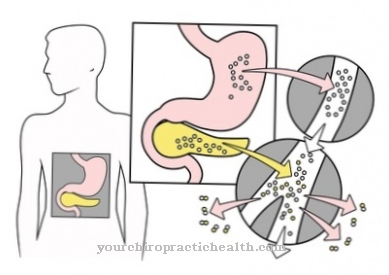Rejection reactions or Rejections are immunological reactions with which the body of a recipient attacks the donor's organ as part of a transplant. Rejections are differentiated according to their time course and can occur hours or years after the transplant. Immunosuppressants prevent this.
What is a rejection reaction?

The immune system is the human defense system. It protects the organism from harmful stimuli and reacts to foreign substances. Immune reactions are a major problem in transplants. In the context of a transplant, there is talk of immunological rejection reactions. The recipient organism acts against the transplant in these reactions. The recipient's immune system uses T cells and antibodies to render the foreign organ harmless.
Different surface structures and different histocompatibility antigens on the cell membranes are the most important reasons for rejection reactions. The surface structure is subject to genetic control. Each individual therefore has a specific and individual surface structure in their cells. One of the best-known rejection reactions is the graft-versus-host reaction, in which the donor tissue containing immune cells triggers an immune reaction against the transplant recipient. We are talking about a reverse immune reaction. As a rule, rejection reactions come from the transplant recipient's immune system.
Transplant rejection is also known as rejection. In addition to the acute form, there is a peracute and a chronic rejection.
Function & task
Immune responses attack foreign organisms or substances and initiate their elimination. In this way, immune reactions protect the body from harmful substances and pathogens. A strong immune system is essential to ward off diseases and microorganisms. In the context of transplants, however, a strong immune system can be disastrous with its actually intended protective reactions. In this context, we speak of rejection reactions or rejection.
Different forms of rejection are distinguished. The time course and the extent of a rejection determine the form of the repulsion. In the case of a peracute rejection reaction, the rejection occurs minutes or a maximum of hours after the transplant is complete. Allo-specific or blood group-specific antibodies trigger the rejection reaction. These immunological substances are already present at the time of transplantation, for example cytotoxic antibodies against HLA or AB0 antigens. In the case of rejection, fibrin is deposited in the transplant vessels after complement activation. This closure causes the tissue to die.
In acute rejection, there are days or weeks between transplantation and rejection. A subtype is accelerated rejection between the second and fifth day after the transplant. Cellular interstitial rejection forms the basis of this type of rejection. Cytotoxic T lymphocytes infiltrate the organ. Another sub-form is acute vascular rejection, during which the transplant recipient's IgG antibodies are directed against the alloantigens in the transplant epithelial cells.
Chronic rejection must be distinguished from acute rejection. This type of rejection occurs months or years after the transplant is complete. There are usually no signs of inflammation. Chronic rejection requires a repeated transplant in most cases. Transplant vasculopathy is the fine tissue cause of chronic rejection. The blood vessels constrict irreversibly and CD4-T effector cells of the TH1 type immigrate into the vessel walls, where they stimulate phagocytes and endothelial cells. The immigrated monocytes become macrophages and secrete TNF-α or IL-1. The vascular walls become chronically inflamed. Because of the fibrosis that occurs in this way, they become scarred and narrow over time.
You can find your medication here
➔ Medicines for cardiac arrhythmiasIllnesses & ailments
Rejection reactions are always a risk with transplants. In the meantime, however, medicine is largely able to reduce this risk.
On the one hand, if possible, transplantation focuses on donor organs with a similar structure. On the other hand, preventive agents such as immunosuppressive therapy to avoid rejection are available. Immunosuppressants suppress the organism's defense reaction against the foreign organ. Long-term immune tolerance is the goal of immunosuppressive therapy. The immune system no longer needs to be suppressed after long-term tolerance to the transplant has occurred.
Unfortunately, this ultimate goal has not yet been achieved through drugs. For this reason, permanent rejection prophylaxis takes place during transplants. Different combinations of drugs have established themselves as a measure against rejection reactions. Induction therapy with immunosuppressants such as ciclosporin or tacrolimus and azathioprine takes place before, during and usually after the transplant. Substances such as mycophenolate and glucocorticoids or antithymocyte globulin antibodies in relatively high doses are also suitable for immunosuppressive purposes.
In addition to the basic therapy, there is long-term medication in the form of a triple combination of steroids and calcineurin inhibitors or everolimus and azathioprine. When administering immunosuppressants, close therapeutic monitoring is recommended during the first few months. The active principles of the drugs are minimized after a certain period of time. Because of the weakening of his general immune defense, the patient of immunosuppression is more vulnerable to bacterial, viral and fungal pathogens.
Research is currently being carried out into the transplantation of exogenous stem cells to exclude immune reactions. If the donor transfers blood-forming stem cells to the recipient in addition to the organ, immune cells are formed after the transplant to prevent rejection. The same principle applies to the transfer of white blood cells, which kill all defensive immune cells after transplantation and promote substances with an immunological regulatory effect.
Medical 3D printing offers further options for preventing immunological rejection reactions in the future. For example, medical research is currently dealing with the colonization of collagen scaffolds from 3D printing. From the point of view of the immune system, such a transplant would be tantamount to a self-donation. The risk of rejection would therefore be minimal.












.jpg)



.jpg)










.jpg)
